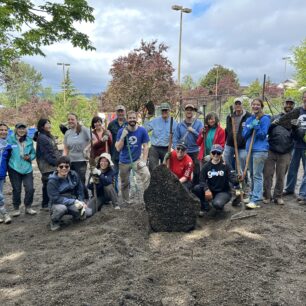
In Deep Water
An RPCV recounts diving to the bottom of the Caribbean to recover a lost motor— and his reputation.
From 1979 to 1981, I was a Peace Corps Volunteer marine biologist and advanced scuba diver assigned to the Barbados Parks and Beaches
Commission to help establish the Barbados Marine Reserve and Marine Museum, the first marine protected area for the island nation.
The Commission wanted me to promote the reserve through cooperative work with underwater filmmakers and marine scientists. On the weekends, when the museum offices were closed, I offered my services to filmmakers and marine scientists staying at McGill University’s Bellairs Research Institute, who were working on coral reef projects within the marine protected area of the reserve. This included the wreck of the SS Stavronikita, a 365-foot freighter that was sunk on purpose in 1978 to create an artificial reef and diving attraction.
In the summer of 1980, two guest divers joined our crew aboard the reserve’s 17-foot open dive boat, the Blue Tang, for a day of underwater work. John Stoneman, a well- known underwater filmmaker from Canada, was on board, as was Dr. Alan Emery, the curator of ichthyology at the Royal Ontario Museum in Toronto. Dr.Emery was on hand to produce a television episode on fish and invertebrate species inhabiting Barbados’ coral reefs. I was the safety diver and boat operator on the Blue Tang for the day—or so I thought. The boat was powered by a single 25-horsepower Johnson outboard motor.

After completing underwater filming, we returned to Bellairs beach, where I off- loaded our camera and diving gear, as well as the passengers. I motored the boat out to the offshore mooring float, about 75 yards from the beach, where we normally tied up the Blue Tang after use. Before tying up to the mooring, I washed down the deck of the dive boat and motored around to let the water get sucked out of a drain at the back of the boat.
Unbeknownst to me at the time, the plywood frame under the fiberglass coating at the stern of the boat was waterlogged, and the clamps holding the Johnson outboard motor were not secure. As I made a sharp turn to return to the mooring float, the motor abruptly jumped off the stern with the throttle wide open and the propeller spinning out of control. The motor plunged into the sea, to an unknown depth, far from the beach.
I freaked out and fumbled around to put the plug back into the drain so no more seawater would flood into the boat, and quickly sighted two triangulation points on the island to make sure I could locate and return to the right spot to recover the motor. I still had no idea how deep the bottom was where the motor sank.
Without the benefit of a motor, I had to row back to the mooring float against the wind in the now-powerless Blue Tang. One of my student friends working at Bellairs, Tom Tomascik, looked out to sea and noticed that I was rowing strangely toward the reserve’s offshore mooring float. He motored out to me in a small boat, laughing as he circled me rowing frantically in the big dive boat that was being blown offshore by the afternoon sea breeze. It was hot, sweat poured down my face, and it took forever to row to the mooring float.
Tom didn’t offer any help, just encouraged me to row faster and more powerfully while laughing unrelentingly.
Finally, I arrived at the mooring float and successfully tied up the Blue Tang. As I rowed the dinghy back to the beach, I wondered how I would ever explain to the commission’s managers that I lost the government’s boat motor in the sea. I was not looking forward to the inevitable telephone call to my supervisor.
On the bright side, I was thankful that I hadn’t been injured by the motor or the propeller as it gashed the boat before sinking. I wondered if my favorite Peace Corps book, Where There Is No Doctor (the book’s 50th anniversary was celebrated in the Fall 2023 issue of WorldView), even covered treatment for such injuries.
The next day, I convinced Dr. Emery, Tom, and Bellairs’ Barbadian dive boat skip- per, Ron Hinds, to help me find the motor. When we finally got close to the spot where I lost the motor, Ron kept saying skeptically, “Paaatrick! No mon, ya cayan neva fyne dat mota out heeea!”
Finally, I said, “This is the spot. I think.” I threw out the anchor with lots of line. It plunged into the turquoise tropical water and dropped endlessly. We all knew we were in deep water. Dr. Emery and I had twin scuba tanks, manifolds, and harnesses set up for the dive since we knew we’d need extra air to find the motor safely at an unknown depth.
Ron and Tom laughed as we rolled back- ward off the boat to begin the dive. I held the end of a steel cable in my hand from a reel that was securely tied down on the Bellairs dive boat. The plan was for Ron to use the reel and a hand crank to bring the motor to the surface.
Tom was our safety diver stationed at 60 feet deep just in case we needed help. We left Tom hanging on the anchor line, as Dr. Emery and I descended. I looked at my depth gauge at 100 feet, but the bottom was not visible. Then, at about 130 feet deep (the maximum depth recommended for recreational diving), I looked down at the sandy bottom, and there was the Johnson outboard motor right next to the anchor blades.
Atmospheric pressure at that depth is more than five times higher than atmospheric pressure at sea level. That means that divers use their air much faster at that depth, and time would be an important factor in recovering the motor from such deep water.
Neither Dr. Emery nor I thought we would need to dive down to 170 feet to get to the bottom, but we continued to descend toward the motor. We both began to experience nitrogen narcosis, also known as “rapture of the deep,” which is a euphoric and disorienting feeling that divers can experience at depths below 100 feet, making our task even more challenging.
Fighting the narcosis, I secured the motor relatively quickly. Dr. Emery signaled to me that he wanted to look around and see what fish were inhabiting the deeper reef area to take advantage of our remaining time at such an unexpected depth. We swam for several more minutes, noting the species of small fish that lived on the sand and around small coral outcrops. I kept an eye on the boat motor and anchor line as our reference point back to the surface.
We both began to experience nitrogen narcosis, also known as “rapture of the deep,” which is a euphoric and disorienting feeling that divers can experience at depths below 100 feet, making our task even more challenging.
Meanwhile, Tom, our safety diver, was becoming concerned about how long we’d spent at the bottom. When we ascended the anchor line to meet him at 60 feet, we gave him the diver’s OK sign that we were in good shape, and the cable was secured to the motor. You could hear Tom laughing underwater and see large trails of bubbles from his diving regulator as he exhaled.
We had to make several decompression stops on our way up to prevent decompression sickness, also known as “the bends,” which can happen after a prolonged deep dive.
When we surfaced safely, Ron asked in his skeptical Barbadian accent, “Wweell wweell wweell, mon, w’appnin now?”
I told him that we attached the cable to the motor, and he could reel it in anytime.
Ron started hand cranking the reel attached to the motor, laughing all the while because he could not believe we’d been successful.
While the Barbados Parks and Beaches Commission celebrated our recovery, they were concerned about the cost of fixing a flooded motor. I thought I might have to pay for the repairs myself, out of my meager Peace Corps Volunteer monthly stipend.
I knew I had to make my best pitch to the repair shop mechanics, so I told them the full story, with Barbadian inflections, describing my triangulation skills, the depth of the “rescue” dive, and my role as a U.S. Peace Corps Volunteer working for the Parks and Beaches Commission with no money to spare. The repair shop guys were so amazed at the story that they fixed the motor for free.
Ron must have told his local friends in Holetown that “Paaatrick” was an expert navigator and a super diver to have found the motor in such deep water. Still, I was a real dummy for letting the motor jump off the boat in the first place. After the whole incident, the local boat operators who knew me would point and wave from their boats or on the beach, saying, “De tru booaat Mon goin’ ta sea.” I always wondered if they were encouraging me or “making sport,” as they say in Barbados. Either way, we were all friends of the Caribbean Sea.
The local park naturalists and I continued to use the Blue Tang for diving and park operations, specimen collections, and under- water photography. The Barbados Marine Reserve and Marine Museum opened on November 29, 1980 on the eve of Barbados’ Independence Day. Since then, thousands of Barbadian residents, schoolchildren, students, tourists, divers, and researchers have visited the museum, experienced the coral reefs within the reserve, and viewed the marine life attracted to the SS Stavronikita wreck.
Patrick Cotter (Barbados 1979–81) is a retired environmental scientist who worked on international pollution programs for the U.S. government.
Related Articles

Made in America
Charlie Clifford (Peru 1967–69) is the founder of Tumi Inc., a global travel luggage brand, as well as Roam Luggage.…

“Bigger Than Peace Corps”
California Service Corps is the largest state-based service program in the U.S. , with more than 10,000 volunteers across the…

Signal Boost
The digital world is awash in voices seeking monetary reward or improved social status, as the online acronym goes, IRL…

Garden of Refuge
As part of our commitment to continued service, the Seattle Peace Corps Association (SEAPAX) is partnering with World Relief Western…





